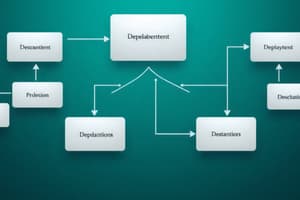Podcast
Questions and Answers
What does a diamond symbol typically represent in a flowchart?
What does a diamond symbol typically represent in a flowchart?
- An alternative path
- A decision-making point (correct)
- A process or step
- Input or output
Which of the following best describes an algorithm?
Which of the following best describes an algorithm?
- A visual representation of a solution
- A decision-making symbol
- A flowchart component
- Precise step-by-step instructions (correct)
What is the primary purpose of flowchart symbols in problem-solving?
What is the primary purpose of flowchart symbols in problem-solving?
- To illustrate decisions and processes (correct)
- To represent random data
- To provide visual entertainment
- To confuse programmers
In a flowchart, what does an oval symbol typically indicate?
In a flowchart, what does an oval symbol typically indicate?
Which type of symbol in a flowchart signifies an alternative path or option?
Which type of symbol in a flowchart signifies an alternative path or option?
What role do algorithms play in relation to flowcharts?
What role do algorithms play in relation to flowcharts?
What type of algorithm solves a problem by breaking it down into smaller subproblems and solving them, eventually combining the results?
What type of algorithm solves a problem by breaking it down into smaller subproblems and solving them, eventually combining the results?
Which algorithm type chooses the best solution at each step, hoping that the resulting global solution will be optimal?
Which algorithm type chooses the best solution at each step, hoping that the resulting global solution will be optimal?
What is one of the essential design principles of algorithms that states an algorithm must produce correct results for all valid inputs?
What is one of the essential design principles of algorithms that states an algorithm must produce correct results for all valid inputs?
When designing algorithms, what principle advocates for an algorithm to be easy to understand, implement, and maintain?
When designing algorithms, what principle advocates for an algorithm to be easy to understand, implement, and maintain?
Flowcharts are visual representations of what in the context of algorithms?
Flowcharts are visual representations of what in the context of algorithms?
Which type of algorithm solves a problem by repeating specific steps until a stopping condition is met?
Which type of algorithm solves a problem by repeating specific steps until a stopping condition is met?
Flashcards are hidden until you start studying
Study Notes
Understanding the Differences between Flowcharts and Algorithms
As you delve into the world of computing and problem-solving, you'll encounter two essential tools: flowcharts and algorithms. Although they may seem closely related, they have distinct purposes and characteristics. Let's explore these differences, starting with flowchart symbols and the types of algorithms, followed by algorithm design principles.
Flowchart Symbols
Flowcharts are visual representations of algorithms, program logic, or problem-solving processes. They use standardized symbols to illustrate decisions, loops, inputs, outputs, and other components involved in a solution. Some of the primary symbols include:
- Rectangle – Represents a process or step, such as input, calculation, or output.
- Diamond – Signifies a decision-making point or condition that needs to be tested.
- Oval – Indicates input or output, such as data provided or results generated.
- Parallelogram – Represents an alternative path or option in a decision.
- Arrow – Indicates the flow of program control or data movement.
These symbols are arranged in a logical order to create a flowchart that visually demonstrates the algorithm's progression through a series of steps.
Types of Algorithms
Algorithms are precise, step-by-step instructions that solve specific problems or perform tasks. They are essential components of flowcharts, guiding the execution of the flowchart's processes. There are several types of algorithms, including:
- Sequential – Follows a linear sequence of instructions.
- Recursive – Solves a problem by breaking it down into smaller subproblems and solving them, eventually combining the results.
- Iterative – Solves a problem by repeating specific steps until a stopping condition is met.
- Dynamic Programming – Solves a problem by breaking it down into subproblems, and storing the solutions to reduce redundancy.
- Greedy – Chooses the best solution at each step, hoping that the resulting global solution will be optimal.
These algorithm types help solve diverse problems in various domains.
Algorithm Design Principles
Developing efficient and effective algorithms is a critical aspect of problem-solving. Some essential algorithm design principles include:
- Correctness – An algorithm must produce correct results for all valid inputs.
- Efficiency – An algorithm's time and space complexity should be as low as possible.
- Simplicity – An algorithm should be easy to understand, implement, and maintain.
- Generality – An algorithm should be applicable to a wide range of problems.
By adhering to these principles, you can design efficient and effective algorithms to solve complex problems.
Putting it All Together
Although flowcharts and algorithms are interconnected, they serve different purposes. Flowcharts are visual representations of algorithms, while algorithms are the precise, step-by-step instructions for solving problems. To create efficient and effective algorithms, it is essential to adhere to various design principles. By understanding the differences between flowcharts and algorithms and their respective components, you'll be better equipped to tackle challenging problems in computing and problem-solving.
Studying That Suits You
Use AI to generate personalized quizzes and flashcards to suit your learning preferences.




